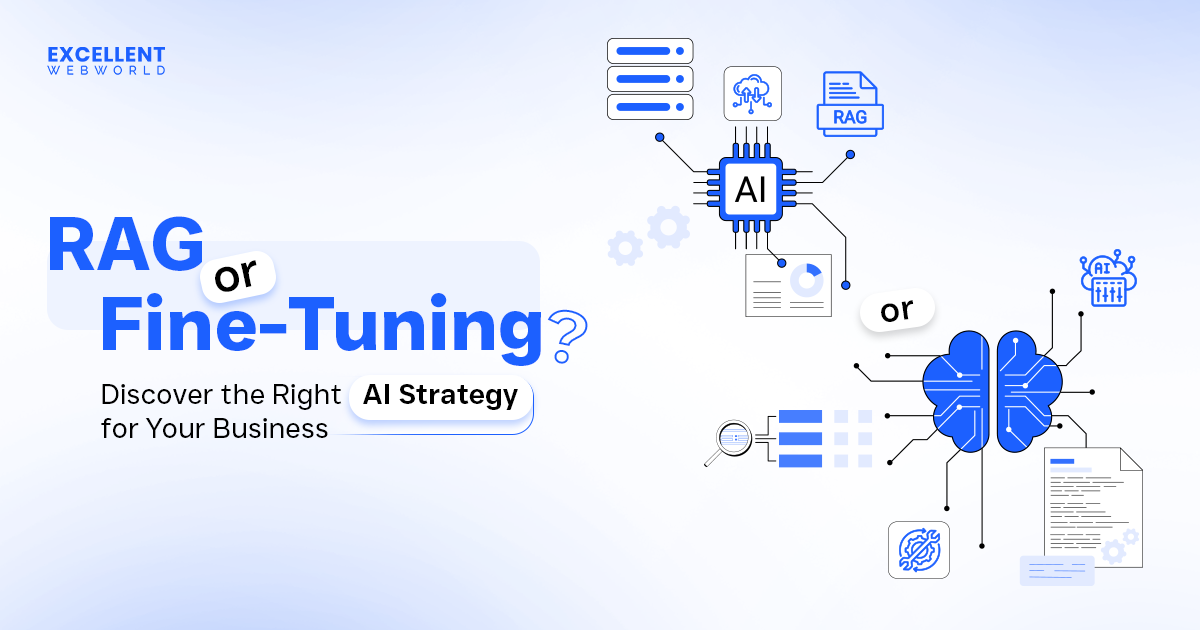Are you planning to integrate AI into your software? But can’t decide which AI model selection for business is profitable.
Choosing the right AI model is critical for businesses aiming to automate complex workflows, improve decision-making, and future-proof their digital infrastructure. Yet many tech leaders face a key dilemma: Should you invest in a Large Language Model (LLM) or a Large Action Model (LAM)?
Models like Large Language Models (LLMs) and Large Action Models (LAMs) interpret, generate, and respond in human language and take actions. The enterprise AI model comparison of LLM vs. LAM highlights the specialized use cases:
Each model has its own unique strengths in different applications. The choice between them impacts everything from integration timelines and scalability to ROI and C-suite justification.
Let’s understand in detail a large language model vs. large action model comparison to understand which model will be more suitable for your business
Understanding Large Language Models (LLM) and Large Action Models (LAM)
While searching for the best AI model for enterprise automation, you need to understand LLM and LAM. As part of emerging software development trends, Both LLM vs LAM for workflow automation respond according to the human intent and optimize tasks.
Simply put, LLMs are like the “brain” that reads, understands, and responds to language. LAMs, on the other hand, are like the “hands”; they take that understanding and turn it into real actions.
LLM vs LAM implementation in legacy systems makes the daily operations smart.
What is a Large Language Model (LLM)?
Large Language Models (LLMs) are AI model evaluations for enterprises specifically designed to understand and produce human language. Built using deep learning techniques, these models are trained on vast amounts of text to learn how words and sentences typically flow.
They use this knowledge to translate languages, summarize articles, answer questions, or chat like humans. The key to their power lies in a special neural network called a transformer. This helps them process massive amounts of information and respond in a way that often feels natural and human-like.
LLMs can also be fine-tuned for specific areas. For example, with some extra training and supervised fine-tuning, they can specialize in fields like healthcare, finance, or law, making them useful for more focused tasks.
What is a Large Action Model (LAM)?
Large Action Models (LAMs) are AI-powered workflow automation built for tasks beyond just understanding language. They’re made to think, plan, and take action. While LLMs are great at reading and writing text, LAMs are better at doing things based on what they read or hear.
LAMs are perfect for situations that need step-by-step reasoning, like controlling robots, making smart decisions on their own, or planning complex tasks. They don’t just answer questions—they figure out what needs to be done and then actually do it.
These models are smart enough to break a problem into parts, understand the big picture, and follow through with actions. In short, if LLMs are great talkers, LAMs are great doers. Businesses often work with AI consulting services to understand how to implement LAMs in real-world environments, optimizing operations through intelligent automation.
LLM vs LAM: Side-by-Side Comparison of AI Models
If you are looking for the core difference between LLM and LAM, it stems from their core architectures and intended applications. As part of the evolving software development process, understanding when to use LLMs vs. LAMs helps teams design more intelligent, responsive systems. Here’s a direct comparison between the two:
Here is a comparison table with multiple factors to understand the LLM vs LAM use cases in industry:
| Factors | LLM | LAM |
|---|---|---|
| Core Purpose | Great at reading, writing, and understanding human language. | Decision-making and executing multi-step processes based on input |
| Main Output | Mostly lives in text-based, virtual spaces like chat or docs | Works in real-world setups connected to apps, devices, and live systems |
| Thinking & Planning | Understands context and language well, but struggles with long, step-by-step plans | Can think ahead, plan steps, and complete complex tasks start to finish |
| How It Acts | Needs people to use its output; can’t act on its own | Works on its own with little help, runs processes, and adapts as needed |
| Integration Style | Mostly uses APIs for text tasks, limited in system-level control | Deeply integrated, talks to software, devices, APIs, and manages real tasks end-to-end |
| Best For | Chatbots, writing tools, translation, summarizing info, and virtual help | Automating workflows, controlling smart systems, and handling real-time business operations |
| Strengths | Writes well, understands tone and context, and is great at creative or conversational tasks | Smart with tasks, plans well, acts fast, and is perfect for business automation |
| Limitations | Can’t take actions, just gives suggestions. Needs strong hardware for big jobs | Not great at creative writing. Needs custom setup and isn’t as flexible with general language |
| Examples | Writes blog posts, summarizes contracts, and chats with customers | Approves invoices, manages inventory, controls devices, or adjusts prices automatically |
After exploring the LLM vs LAM technical comparison, you may think about which model will be suitable for your project. Well, you need to explore specific requirements.
How to Choose Between LLM and LAM for Your Enterprise AI Project?
After comparing both models, you may be stuck with the question, “How to choose between LLM and LAM for digital transformation?”
Well, picking the right model, LLM vs LAM, depends on what your project really needs. It’s not one-size-fits-all. Here are some guiding factors to consider when deciding between LLMs and LAMs
When to Choose a Large Language Model (LLM)
If the goal is language fluency, comprehension, or coherence, such as generating content efficiently for various purposes such as blogs or social media posts. Additionally LLMs are good to work in specialized fields like healthcare, law, etc.
| Enterprise Question | LLM Guidance | Why It Matters |
|---|---|---|
| Is the main job to understand or create text? | Yes—LLMs are great at reading, writing, and translating. | They’re built to work with language. |
| Need help reviewing or summarizing documents? | Yes—LLMs can scan tons of text and pull out the key stuff. | Saves time by turning messy info into clear insights. |
| Is your input and output just text (emails, chat, docs, code)? | Yes—LLMs work best in text-only tasks. | They love clean, text-based pipelines. |
| Want to build a chatbot or virtual assistant? | Yes—LLMs make conversations sound human and helpful. | They give smart, context-aware replies. |
| Just need suggestions, not full task execution? | Yes—LLMs can guide and advise, but not act. | Use them for thinking, not doing. |
| Don’t need complex multi-step planning or real-time action? | Yes—LLMs are fine for simple replies or short back-and-forths. | They’re not made for deep automation. |
| Do you mostly have text data to train on? | Yes—LLMs thrive on lots of good-quality words. | The better your data, the smarter the model. |
| Is easy setup, scale, and cost a priority? | Yes—LLMs can plug into your tools with little effort. | Many are cloud-based and flexible. |
| In a regulated field that needs clear, compliant responses? | Yes, you can fine-tune LLMs to follow rules. | Great for industries like law or finance. |
| Need to support many languages or technical terms? | Yes—choose LLMs that can speak many languages or handle jargon. | They can be tailored for your industry. |
| Is fast response time important? | Yes—use lighter LLMs for quick chats or support bots. | Speed matters for a smooth user experience. |
| Can you handle occasional wrong answers? | Yes—with good checks and human review, LLMs are safe to use. | You can control the risk of “hallucinations.” |
| Want to tailor the model to fit your business? | Yes—LLMs can be tested and trained on your tasks. | Custom tweaks give better results. |
When to Choose a Large Action Model (LAM)
If the goal is taking actions depending on the understanding, such as agent-based applications that include autonomous bots, assistants, and task managers. Additionally, LAMs are good if you want an app that involves contextual memory, which is not possible in LLM.
| Enterprise Question | LLM Guidance | Why It Matters |
|---|---|---|
| Is your main job to read, write, or understand text? | Yes—LLMs are built for language tasks like writing, chatting, and translating. | They shine when it comes to working with words. |
| Need to scan and summarize long documents fast? | Yes—LLMs can find key info and write summaries in seconds. | They handle messy data and turn it into clear takeaways. |
| Is your input and output mostly text (like emails, chat, or code)? | Yes—LLMs are text-first, both for reading and writing. | Perfect match for text-based workflows. |
| Want to build a chatbot, assistant, or support bot? | Yes—LLMs can chat like a human and answer smartly. | They keep the conversation natural and helpful. |
| Just need suggestions, not actions? | Yes—LLMs offer ideas, insights, and answers—not actions. | Think of them as a smart advisor, not a doer. |
| Don’t need complex, step-by-step automation? | Yes—LLMs handle simple chats or replies, not full-on workflows. | They’re great for short conversations, not big tasks. |
| Have lots of high-quality text data? | Yes—LLMs get better with rich, domain-specific data. | Good data = smarter model output. |
| Want an easy-to-deploy, cost-friendly solution? | Yes—LLMs can be added via APIs with a basic setup. | Many are cloud-ready and scale well. |
| Work in a field where rules and transparency matter (e.g., finance, law)? | Yes—LLMs can be customized to follow rules and stay clear. | You get reliable output that meets compliance needs. |
| Need to handle multiple languages or technical terms? | Yes—LLMs can learn your industry lingo and talk in many languages. | Great for global or specialized businesses. |
| Need fast replies in real-time apps? | Yes—smaller LLMs respond quickly for smooth chats. | Speed boosts user satisfaction. |
| Can you deal with occasional wrong answers? | Yes—with checks and tuning, you can manage that risk. | Mistakes happen, but can be minimized. |
| Want to test and tweak the model for your needs? | Yes—LLMs can be fine-tuned and tested on your real tasks. | Custom fit leads to better results. |
AI implementation challenges, particularly LLM and LAM integration challenges often arise while implementing in a specific industry software. To overcome these challenges, you need to start with a clear strategy. Look for the area of improvement you want to see. Analyze the ROI of LLM vs LAM in enterprise IT: is it worth it?
You can go for an established AI software development company for outsourcing. It will help you to avoid numerous initial mistakes and also automate tasks by building an AI agent and making the journey smooth and seamless.
Divide the project into multiple phases that can be updated later. Additionally, developing an MVP will help you to gather feedback and control the AI-assisted software development within a budget.
How Excellent Webworld Supports Your Enterprise AI Model Selection
If you plan to integrate or build an AI model into your app, LLM vs LAM: Both are powerful, reliable, and capable of handling most AI tasks.
Whether for decision-making, actionable agent bots, or responding humanely, we help bring your AI idea to life.
We handle everything from choosing the correct model to building and launching your app. Excellent Webworld is an experienced AI software development company with domain expertise.
We have over 13 years of experience providing software development services for various industries. Our team of experts has successfully developed high-performance software solutions that integrate advanced AI technologies. With more than 900 successful projects, our experts have catered to different client needs in various industries.
Let’s turn your idea into a real-world experience. Book your free consultation today!
FAQs on Enterprise Adoption of LLM vs LAM AI Models
Yes, a large language model is a kind of neural network made using deep learning. It’s built on something called a transformer, a special type of neural network that helps it understand and generate human-like text.
A Large Action Model (LAM) is an advanced AI that not only understands and generates language like LLMs but can also take real actions and interact with the world around it.
LLMs are great at understanding and writing human-like text, making them useful for many tasks like writing, translating languages, and answering queries.
Training a large action model starts by feeding it a lot of data, like user actions and context. Then, the model learns how to predict and carry out the best steps based on that information.

Article By
Mahil Jasani began his career as a developer and progressed to become the COO of Excellent Webworld. He uses his technical experience to tackle any challenge that arises in any department, be it development, management, operations, or finance.



